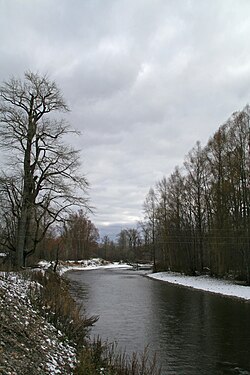Tym (Sakhalin)
| Tym | |
|---|---|
 | |
 Location of themouthof the Tym inSakhalin Oblast | |
| Etymology | Nivkhfor "spawning river" |
| Native name | Тымь(Russian) |
| Location | |
| Country | Russia |
| State | Sakhalin Oblast |
| Physical characteristics | |
| Source | Mount Lopatin, East Sakhalin Mountains |
| Mouth | Nyysky Bay, Sea of Okhotsk[1] |
• coordinates | 51°52′07.62″N143°10′57.45″E/ 51.8687833°N 143.1826250°E |
| Length | 330 km (210 mi) |
| Basin size | 7,850 km2(3,030 sq mi) |
| Discharge | |
| • average | 89 m3/s (3,100 cu ft/s) |
TheTym(Russian:Тымь) is a river on the island ofSakhalin,Russia,and the second longest river on the island after thePoronay.It is 330 kilometres (210 mi) long, and has adrainage basinof 7,850 square kilometres (3,030 sq mi).[2]The name of the river is translated fromNivkhas "spawning river." The river flows throughTymovskyandNoglikiDistricts ofSakhalin Oblast.It begins on the southern slopes of Mount Lopatin in the East Sakhalin Mountains, flows through swampy lowlands in the Tym-Poronaiskaya Valley, and finally flows into Nyisky Bay in theSea of Okhotsk.The villages ofTymovskoyeandNoglikiare located beside the river.
The river is mostly fed bysnowmelt.The Tym freezes between November and early December, and the spring break occurs between the end of April and May.[1]The highest level of flow has been observed in the second week of May, and the lowest has been observed in the third week of August. There are about 400lakesin the river's basin, with a combined area of about 9.5 km².

The largesttributariesof the Tym are listed below, with their length in kilometers given in parentheses:
Right tributaries
- Pilenga (63)
- Parkata (60)
- Imchin (59)
- Uskov (39)
Left tributaries
- Nysh (116)
- Chachma (93)
- Little Tym (66)
- Aleksandrovka (48)
- Red (46)
The river isnavigableby rafts and light boats up to 80 km (50 mi) from its mouth. The passage oftyphoonscan bring significantflooding.[1]The Tym and its tributaries are rich in spawningsalmon.[3][4]
Someagricultureis carried out in the Tym valley, producingpotatoesandvegetables,as well as raisingcattleformeatanddairy products.Although the growing season averages less than 100 days,Sovietscientists optimistically called the river valley "the granary of Sakhalin". To this end, acollective farmcalled "Krasnaya Tym" ( "Red Tym"; coordinates50°47′11″N142°40′23″E/ 50.78639°N 142.67306°E) was established in Soviet times. Timber is also harvested in the valley.[5][6]

References
[edit]- ^abcТымь,Great Soviet Encyclopedia
- ^"Река ТЫМЬ in the State Water Register of Russia".textual.ru(in Russian).
- ^Kovtun, A.A. (2000)."Wild and Hatchery Production and Recruitment of Autumn Chum Salmon (Oncorhynchus keta Walbaum) in the Tym River, Sakhalin, 1960-1998"(PDF).North Pacific Anadromous Fish Commission Bulletin(2): 255–261.Retrieved22 September2013.
- ^Skopets, Mikhail."Tym River Impromptu."Fly Fishing Russia. Blog post, 24 March 2012. Retrieved 22 August 2012.
- ^Ivlev, A. M.Soils of Sakhalin.New Delhi: Indian National Scientific Documentation Centre, 1974. Print.
- ^"Regional Cities."SAKHALIN.RU: Sakhalin and the Kuriles.2004. Retrieved 23 August 2012. (See "Tymovskoye." )
